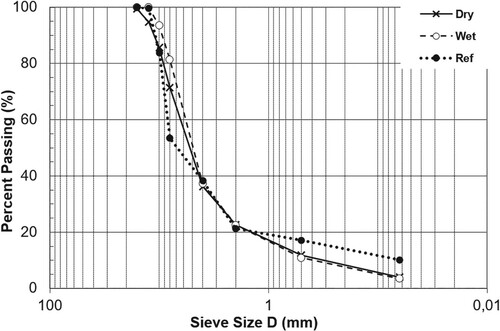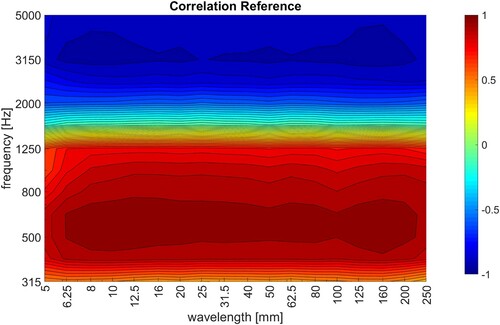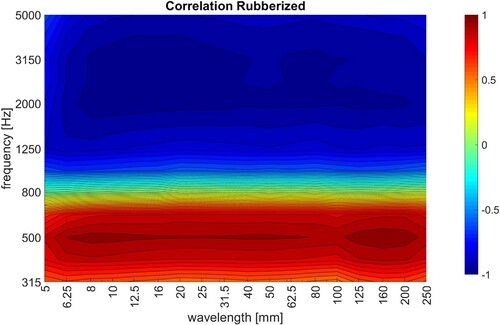 ?Mathematical formulae have been encoded as MathML and are displayed in this HTML version using MathJax in order to improve their display. Uncheck the box to turn MathJax off. This feature requires Javascript. Click on a formula to zoom.
?Mathematical formulae have been encoded as MathML and are displayed in this HTML version using MathJax in order to improve their display. Uncheck the box to turn MathJax off. This feature requires Javascript. Click on a formula to zoom.Abstract
Road traffic noise is the most common source of environmental pollution in urban areas, and therefore, the study of noise mitigation actions is fundamental for urban planning. The use of low noise road surfaces is one of the most widespread intervention since it acts directly on the source of road traffic noise, represented by tyre/road interaction. In this work, the interaction between texture and tyre/road noise was studied from an experimental point of view, by comparing CPX and road texture measurements on rubberised and standard road surfaces. Tyre deformation was addressed by taking into account the indenter method proposed by Sandberg and Goubert in 2018. Regressions of CPX and enveloped road texture levels were performed separating rubberised from reference surfaces, and parallelism tests were performed on the slopes. Results show that the use of rubber influences the interaction of road texture and noise, especially at high frequencies.
Introduction
Noise pollution produced by transport infrastructures is a very widespread issue for modern society, especially within cities and other urbanized areas. Indeed, after 15 years from the 2002 European Environmental Noise Directive (END) emission, a revision (European Commission, Citation2017) reported that noise pollution still represents a serious health problem in Europe, with road traffic representing the most common noise source. About 100 million people in the 33 EU member states are exposed to harmful road traffic noise levels exceeding 55 dB(A) of Lden, and 32 million are exposed to noise levels higher than 65 dB(A) of Lden. An exposure to these levels could lead to a series of issues, such as sleep disorders with awakenings (Muzet, Citation2007; Skrzypek et al., Citation2017), learning impairments (Hygge et al., Citation2002; Lercher et al., Citation2003), cardiovascular, hypertension and ischemic heart disease (Babisch et al., Citation2012; van Kempen et al., Citation2018) and annoyance (Guski et al., Citation2017; Miedema & Oudshoorn, Citation2001; Okokon et al., Citation2015). One of the solutions adopted by the END is the institution of mandatory action plans for big infrastructures or urban agglomerations (Licitra et al., Citation2017b). Bearing this prospect in mind, the study of noise generation mechanisms is of paramount interest in order to optimize mitigation actions (Ögren et al., Citation2018).
Previous studies (Kuijpers & Van Blokland, Citation2001; Sandberg & Ejsmont, Citation2002) show that tyre-road noise is a remarkably complex phenomenon, which results from the combination of airborne and structure-borne phenomena, where the source is provided by the contact between tyre and pavement. Airborne noise is related to compression of the air trapped within the tread of the rolling tyre (Morgan et al., Citation2007). These mechanisms are known as air pumping, and cause noise at frequencies higher than 1 kHz. Other than air pumping, airborne mechanisms also include pipe and Helmholtz resonances, due to the coupling of a vibrating mass of air within the tread, which acts as a cavity (Sandberg & Ejsmont, Citation2002).
Structure-borne noise covers frequencies lower than 1 kHz and is due to tyre vibrations caused by the impact of the tyre against irregularities of the road surface and by non-linear effects, such as the stick-and-slip and stick-and-snap mechanisms (Kuijpers & Van Blokland, Citation2001). While the former is caused by the motion of the tyre treads with respect to the road surface, the latter is present when the grip on the tyre is too strong, as it can happen on newly laid road surfaces.
Since noise reduction at the source is very cost-effective treatment, compared to actions at receivers or along the propagation path (Praticò & Anfosso-Lédée, Citation2012), European studies such as SILENCE (SILENCE, Citation2005), SILVIA (Descornet, Citation2006), QCITY (QCITY, Citation2008) have focused on actions based on low emission road surfaces such as porous asphalts, stone mastic asphalts, thin, very thin and ultra-thin surfacing, and road surfaces that incorporate rubber deriving from end-of-life tyres. Besides reducing noise, the use of rubber has also the great environmental benefit of recycling rubber, inserting the noise mitigation action in a green and circular economy. The main applications of rubber in pavements are in porous elastic road surfaces (PERS) and rubberised surfaces; the former uses rubber as main component of the mix, while the latter mixes rubber with common asphalt components. More in detail, a PERS (Sandberg et al., Citation2005) is a mix whose air void content ranges from 20 to 40% in volume, while its rubber content reaches 90% of weight. It consists of an aggregate of rubber granules and fibres, with a supplement of sand, stones or other additives, bound together by bitumen or polyurethane. On the other hand, rubberised road surfaces are built using hot asphalt mixes containing crumb rubber which acts as a modifier, in order to improve the acoustical properties of the binder (Shatnawi, Citation2011). The wet process, named Asphalt Rubber (AR), crumb rubber is blended with liquid asphalt cement (AC) before mixing AC with the aggregate. According to the American Society for Testing and Materials International (ASTM, Citation2005), the definition of Asphalt Rubber is:
a blend of asphalt binder, reclaimed tyre rubber and additives in which the rubber component is at least 15% by weight of the total blend and has reacted in the hot asphalt binder sufficiently to cause the swelling to the rubber particles.
In the dry process, crumb rubber is added to the hot aggregate, usually in the range of 1–3% of the weight of the total mixture before adding the asphalt cement. In this process, rubber can be used in fine or coarse crumb, in order to match the aggregate grading and improve its properties. Praticò et al. (Citation2015) reported that although at the moment the dry process lacks standards, it has greater potential as far rubber recycling is concerned.
The acoustical performances of these pavements are in constant monitoring since their birth. Zetterling and Nilsson (Zetterling & Nilsson, Citation1990) compared PERS to traditional surfaces, concluding that the use of PERS leaded to a reduction in roadside levels of about 10 dB(A). During the ‘90s, several studies used the CPX method (International Organization for Standardization [ISO], 11819-2:Citation2017) for the evaluation of tyre/road noise, suggesting that rubberised surfaced provide better conditions for noise reduction, compared to traditional road surfaces (Paje et al., Citation2010).
More recently, rubberised surfaces started to gain popularity in the Italian scenario and therefore several studies were carried out in order to assess their effectiveness as a mitigation action. As a consequence, specific projects have been launched, in order to check the effectiveness of these road surfaces. In particular, in 2006 the Region of Tuscany started the Leopoldo project, with the aim to improve the knowledge in the design and the characterisation of low-noise road surfaces, producing guidelines helpful to the public administrations (Licitra et al., Citation2015). For this purpose, rubberised surfaces produced according to the wet and dry process were laid on extra-urban main roads. Their acoustical performances were monitored by evaluating tyre/road noise emission for several years. Results showed that the use of rubberised surfaces leads to a reduction of noise emission compared to standard dense asphalt concrete surfaces of the same age.
While studies regarding optimal road texture and mixture design for noise abatement are widely available (Hamet & Klein, Citation2000; Losa et al., Citation2013; Losa et al., Citation2010; Praticò, Citation2014) and regulations such as the Regulation E.U. “No 1222/2009” suggest tyre characteristics that are useful to decrease tyre/road noise, the different interaction between tyre/road noise and road texture caused by the presence of rubber in the asphalt mix remains a topic yet to be covered. The purpose of this work is to try to fill this gap using CPX and road texture measurements on 17 different road surfaces. The sample studied contained both dry and wet rubberised surfaces as well as dense asphalt concrete surfaces. In order to study the effect of rubber on tyre/road noise, the correlation between mean CPX levels and road texture levels for each one-third octave bands were calculated, showing that results vary between rubberised and standard dense asphalt concrete surfaces. Linear regressions between each couple of noise and texture bands were also performed, separating rubberised and standard road surfaces; the resulting slopes were compared using a test for parallelism based on t-statistics.
Methods
Noise and road texture measurements were carried out within two different sessions; the first one during November 2017, the second one is dated September 2018. The 17 sites analysed are all part of the motorway that connects Merano to Bolzano, located in the region of Trentino-Alto Adige/Südtirol in Northern Italy. The maximum distance between sites is about 20 km and the difference in height at the starting and ending point of the highway is about 100 m, therefore it is safe to assume that the sites are exposed to the same weather and traffic conditions, thus minimising ageing influence on measurements. It is known, in fact, that ageing effects such as cracking, clogging, rutting, bleeding, binder removal, aggregate polishing among others (Chai et al., Citation2014; Huayang, Citation1995; Miller & Bellinger, Citation2014; Dave & Buttlar, Citation2018) can lead to the deterioration of the acoustical properties of the road surface (Licitra et al., Citation2019).
The 10 rubberised surfaces are divided into two sub-samples of equal size, according to their production method, i.e. 5 dry surfaces and 5 wet surfaces. The remaining seven are dense asphalt concrete (DAC) surfaces and are used as reference. The mean gradation curves of the dry, wet and reference surfaces are reported in Figure .
The close proximity (CPX) method
The CPX method (ISO, 11819-2:Citation2017) aims to evaluate tyre/road noise close to its source, i.e. the contact interface between tyre and road surface, by placing at least two microphones close to the tyre. In this paper, an adapted CPX method was used, with modifications regarding data post-processing (Licitra et al., Citation2017a). The protocol of measurements is based on the last version of ISO 11819-2, and, therefore, the Standard Reference Test Tyre (SRTT) was used. Moreover, since tyre/road noise is dependent on air temperature and tyre hardness, normalisations were performed in compliance with ISO 11819-2, which suggests a reference temperature of 20°C and a reference hardness of 66 Shore A.
Since tyre/road noise is also dependent on speed, a comparison between different surfaces is possible only after a reference speed has been chosen. The nature of the roads under investigation has led to the choice of 100 km h−1.
During the measurement sessions, several acquisitions on the same surface were performed at different speeds. A minimum χ2 iterative algorithm was used in each segment for fitting sound levels with speed, in order to compute the one-third octave bands spectrum at the reference speed. Finally, the mean value of the sound pressure level within each band is used to characterise the whole site.
The main modification to the official protocol regards data analysis, since the test sites were divided into segments 6.18 m long, i.e. three times a tyre circumference, instead of using the standard section length of 20 m, in order to increase the spatial resolution of the analysis.
Despite temperature and hardness corrections are strictly valid only for broadband levels, in this work the same correction has been applied to the one-third band levels, due to the current lack of studies on this topic.
Road texture measurements
Road texture measurements and CPX measurements were carried out simultaneously. For these measurements, a triangulations point profile sensor compliant with the requirements reported in ISO 13473-2 was used. The set-up is based on a measurement system mounted on a self-powered vehicle, where the CPX equipment and the profilometer for texture measurements are deployed at once, thus ensuring perfect alignment of signals and same measuring conditions.
Using the same terminology adopted in ISO, 13473-2:Citation2002, the profilometer used during measurements is a contactless profilometer, and is based on the setup described by Del Pizzo et al. (Citation2018). The output of the laser triangulation sensor, fixed to the rear of the vehicle, is combined with the information provided by a rotary encoder fixed to a wheel that yields the horizontal distance travelled. A piezoelectric accelerometer measures vertical oscillations of the laser sensor, providing a passive cleaning of measurements. The indenter algorithm is then used to simulate the tyre envelopment resulting from the 2D road profile sampled at 0.5 mm, following the same procedure used by Del Pizzo et al. (Citation2019). This algorithm is based on the method proposed by Sandberg and Goubert, derived from experimental measures performed by driving the SRTT on a known profile (Goubert & Sandberg, Citation2018). It has been shown (Del Pizzo et al., Citation2019) that the resulting tyre envelopments correlate better with noise emission than the original profile, and therefore the use of this method results crucial in the evaluation of texture influence on tyre/road noise.
The profile obtained after the tyre envelopment is divided into segments and fitted with an autoregressive model based on the Yule-Walker method, reducing signal noise. Then, the one-third octave spectra are derived following the prescriptions of the fourth method reported in ISO/TS, 13473-4:Citation2008.
Measurement uncertainties
Mean CPX levels, named LCPX hereafter, have three main sources of uncertainty:
Fitting process in each segment, due to data dispersion around the fit. This source is assumed to be the measurement uncertainty of sound pressure level within each segment;
Data dispersion around the mean value, represented by the standard deviation of the segment LCPX for each road surface. The standard deviation of data describes the spatial homogeneity of an installation and cannot be neglected when two road surfaces are compared;
Several factors and processes, whose cause and nature of disturbance are either known, but randomly distributed in an uncontrollable way, or are of a systematic nature, but affect the result in an unpredictable way (ISO, 11819-2:Citation2017).
Since the conditions of measurements do not vary greatly within the different sessions, this source was neglected in the analysis.
As far as road texture is concerned, an estimate of measurement uncertainties for texture spectra within a segment is derived using Equation (1) (Del Pizzo et al., Citation2019):
(1)
(1) where
is the width of the band centred in k, L is the length of each segment.
Data dispersion around the mean value was also taken into account by evaluating the standard deviation of each band for each site. The uncertainty of each band is given by the quadratic sum of standard deviation
of the texture levels along the installation and the term provided by Equation (1):
(2)
(2)
Noise and texture correlation
At first, the correlation coefficient was evaluated separately for each couple of enveloped texture and noise bands for the reference and the rubberised surfaces. The results were used to evaluate differences between the two kinds of road surfaces.
A deeper investigation was brought about by performing weighted linear regressions for each couple of CPX and enveloped texture band of each kind of surfaces, i.e. the reference ones and the rubberised ones. Using the adjusted coefficient of determination, slopes where both regressions showed a high goodness-of-fit were compared using a parallelism test based on a bilateral t-test. The statistics were calculated from Equation (3):
(3)
(3) where b1 is the slope of the regression for the rubberised surfaces and b2 is the slope of the regression for the reference surfaces and
is the standard error of the difference of the two angular coefficients. The values provided by Equation (3) were then used to test the hypothesis:
(4)
(4) comparing each
with the critical value tcrit(0.975) = 2.16 for (n1−2 + n2−2) degrees of freedom, where n1 = 10 is the number of rubberised surfaces and n2 = 7 is the reference surface sample size.
Analysis and results
Correlation curves are shown in Figures and are in accordance with previous studies, with low frequency noise positively correlated with road texture and a high frequency zone negatively correlated with road texture.
As it can be inferred by observing the figures, the influence of crumb rubber in the mix of the bitumen modifies the correlation curves, extending the frequencies negatively correlated with texture and reducing the positively correlated frequency bands. This widening of the negatively correlated zone could represent a significant acoustical benefit of the usage of rubberised surfaces against the reference dense asphalt concrete surfaces.
In order to understand which regressions were suitable for testing, goodness-of-fit was taken into account separately for the two kinds of surfaces. The adjusted coefficient of determination r2adj of the regressions is shown in Figures and .
Figure 4. Adjusted coefficient of determination for reference surfaces for each couple of CPX band and enveloped texture band.
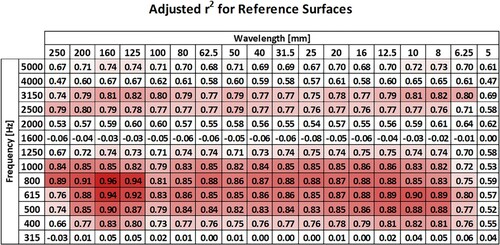
Figure 5. Adjusted coefficient of determination for rubberised surfaces for each couple of CPX band and enveloped texture band.
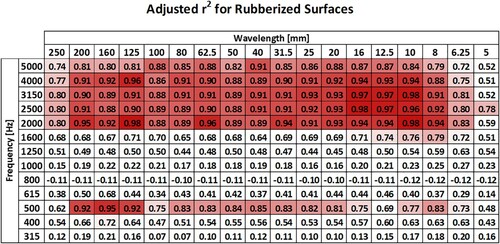
Only the regressions showing coefficient of determination higher than 0.7 for both kind of pavements were used in the statistical test described by Equation (3). The resulting tscore is shown in Figure .
Figure 6. Reduced matrix of the t-values for the regression slopes. Blue cells highlight regions where the regressions are statistically different, while red cells identify zone where no statistical difference is found.

From Figure , two distinct zones were identified:
For the 500 Hz one-third octave band, slopes characterised by high values of the coefficient of determination are not statistically different at 95% confidence level;
For the 2500 Hz one-third octave band, slopes with high values of the coefficient of determination are statistically different at 95% confidence level;
The 500 Hz one-third octave band is related to structure-borne noise, due to tyre vibrations, and therefore, it is reasonable to assume that adding crumb rubber to the mix design does not improve the acoustical performances of the road surface. In fact, slopes in this region do not show differences at a 95% confidence level. However, when high frequency noise is taken into account, rubberised surfaces are different from standard surfaces. Noise in this region is related to airborne phenomena rather than to tyre vibrations, and, therefore, differences in the mixes used are expected to induce changes from an acoustical point of view. Coherently with other previous studies, the inclusion of crumb rubber in the mix appears to have a positive effect on noise reduction, since it leads to a greater negative correlation between road texture and noise at 2500 Hz. For example, Figure shows experimental data and regressions for the two different frequency bands.
Figure 7. Examples of linear regression of data. The left figure shows a case where the parallelism test was successful. On the right, two statistically different regressions are plotted.

The effect of rubber is evident when comparing the slopes of the regressions between high frequency noise and enveloped road texture at 10 mm wavelength: the higher negative slope for rubberised pavements points out a greater noise reduction potential compared to traditional surfaces. This effect is also of uttermost importance when comparing the overall acoustic performances of road surfaces: while it is true that CPX measurements are usually peaked around 1 kHz, the maximum of the A-weighting curve is at 2.5 kHz, which makes noise reduction in this band even more significant.
Conclusions
To date, low noise emission surfaces represent the best solution to mitigate noise for roads with high and continuous traffic flows, both in urban and extra-urban contexts. Rubberised asphalts probably are the best choice in the modern concept of green and circular economy, since they use end-of-life tyres to improve the properties of road surfaces, which have been studied since their birth. However, despite their application is globally growing, the basic mechanisms of its noise reduction properties are still not fully explained. The present work studied the variation of the interaction between road texture and tyre/road noise due to the insertion of rubber in a pavement mix. The study was carried out from an experimental point of view, by comparing measurements on ten rubberised and 7 standard road surfaces. Tyre/road noise measurements were performed using the CPX method, while road texture was measured using a triangulation sensor. Tyre envelopment was also calculated, in order to provide the tyre deformation due to the contact with the road surface.
Analysis of the correlation coefficient in one-third octave bands between CPX and enveloped texture showed that tyre/road noise results more influenced by the presence of rubber at high frequencies, which are related to airborne phenomena, while lower frequencies, related to tyre vibrations, do not show significant differences in the correlation curves.
In order to bring about a comparison from a statistical point of view, a parallelism test was used on the linear regressions performed between enveloped road texture and CPX noise levels for the rubberised and standard surfaces. The two regions where both fits show an adjusted coefficient of determination higher than 0.7 were the 500 Hz band, which does not show statistical difference between the two kinds of surfaces, and the 2.5 kHz band, where, on the contrary, evidence of statistical difference was found at a 95% confidence level. The higher negative slope for the 2.5 kHz band highlights the greater noise reduction potential of rubberised pavements compared to the conventional road surfaces.
Three main factors contribute to the research significance of this study. Firstly, external conditions of the road surfaces that were analysed are pretty unique and difficult to find elsewhere. Indeed, the experimental sites are within a 20 km radius and thus are exposed to the same weather and traffic conditions, reducing the influence of other factors involved in acoustic degradation of roads. Secondly, the tyre envelopment algorithm based on experimental measures used in this work still has not yet been extensively tested. Its use is fundamental for the calculation of a realistic tyre deformation due to the contact with the road surface. Lastly, despite the statistical approach adopted for the comparison is a known tool especially for medicine studies, it has proved to be exceptionally powerful for finding evidence of different behaviour between the rubberised and reference surfaces. Further developments of this study could include the use of more sensors at once in order to reduce measurement uncertainties. A laser with smaller spot size could also expand the range of wavelengths studied, since it is known that tyre/road noise is affected by shorter wavelengths. Increasing the sample size would represent a further improvement to the present study.
Correction Statement
This article has been republished with minor changes. These changes do not impact the academic content of the article.
References
- ASTM. (2005). ASTM international annual book of standards, D 8 definitions, 2005. ASTM.
- Babisch, W., Swart, W., Houthuijs, D., Selander, J., Bluhm, G., Pershagen, G., & Sourtzi, P. (2012). Exposure modifiers of the relationships of transportation noise with high blood pressure and noise annoyance. The Journal of the Acoustical Society of America, 132(6), 3788–3808. https://doi.org/https://doi.org/10.1121/1.4764881.
- Chai, G., Van Staden, R., Chowdhury, S. H., & Loo, Y. C. (2014). A study of the effects of pavement ageing on binder deterioration. International Journal of Pavement Engineering, 15(1), 1–8. https://doi.org/https://doi.org/10.1080/10298436.2012.752823.
- Dave, E. V., & Buttlar, W. G. (2018). Mechanisms of cracking: Characterisation and modelling.
- Del Pizzo, L. G., Bianco, F., Teti, L., Moro, A., & Licitra, G. (2018, July 8–12). A new approach for the evaluation of the relationship between road texture and rolling noise. Proocedings of ICSV25, Hiroshima, Japan.
- Del Pizzo, L. G., Teti, L., Bianco, F., Moro, A., & Licitra, G. (2019). Influence of texture on tyre road noise spectra in rubberized pavements. Manuscript submitted for publication.
- Descornet, G. (2006, June 12–15). Silvia–sustainable road surfaces for traffic noise control: Goeteborg. Proceedings from transport research Arena Europe. Safer and Smarter road transport for Europe, Göteborg, Sweden.
- European Commission. (2017). Report from the Commission to the European Parliament and the Council on the Implementation of the environmental noise directive in accordance with article 11 of Directive 2002/49/EC ( COM/2017/015).
- Goubert, L., & Sandberg, U. (2018, May 2–4). Enveloping texture profiles for better modelling of the rolling resistance and acoustic qualities of road pavements. 8th Symposium on pavement surface characteristics (SURF), Brisbane, Queensland, Australia.
- Guski, R., Schreckenberg, D., & Schuemer, R. (2017). WHO environmental noise guidelines for the European region: A systematic review on environmental noise and annoyance. International Journal of Environmental Research and Public Health, 14(12), 1539. https://doi.org/https://doi.org/10.3390/ijerph15112400. doi: https://doi.org/10.3390/ijerph14121539
- Hamet, J. F., & Klein, P. (2000, August 27–30). Road texture and tire noise. Proceeding of inter noise, Nice, France.
- Huayang, Z. (1995). On the low temperature cracking of asphalt pavements. Kth Infrastruktur Och Samhaellsplanering Rapport, 95, 7. https://trid.trb.org/view/470289.
- Hygge, S., Evans, G. W., & Bullinger, M. (2002). A prospective study of some effects of aircraft noise on cognitive performance in schoolchildren. Psychological Science, 13(5), 469–474. https://doi.org/https://doi.org/10.1111/1467-9280.00483.
- ISO 11819-2:2017. Acoustics – measurement of the influence of road surfaces on traffic noise – Part 2: The close-proximity method. ISO.
- ISO 13473-2:2002. Characterization of pavement texture by use of surface profiles – Part 2: Terminology and basic requirements related to pavement texture profile analysis. ISO.
- ISO/TS 13473-4:2008. Characterization of pavement texture by use of surface profiles – Part 4: Spectral analysis of surface profiles. ISO.
- Kuijpers, A., & Van Blokland, G. (2001, August 27–30). Tyre/road noise models in the last two decades: A critical evaluation. Proceedings of inter-noise and noise-con congress and conference no. 2, The Hague.
- Lercher, P., Evans, G. W., & Meis, M. (2003). Ambient noise and cognitive processes among primary schoolchildren. Environment and Behavior, 35(6), 725–735. https://doi.org/https://doi.org/10.1177/0013916503256260.
- Licitra, G., Ascari, E., & Fredianelli, L. (2017b). Prioritizing process in action plans: A review of approaches. Current Pollution Reports, 3(2), 151–161. https://doi.org/https://doi.org/10.1007/s40726-017-0057-5.
- Licitra, G., Cerchiai, M., Teti, L., Ascari, E., Bianco, F., & Chetoni, M. (2015). Performance assessment of low-noise road surfaces in the Leopoldo project: Comparison and validation of different measurement methods. Coatings, 5(1), 3–25. https://doi.org/https://doi.org/10.3390/coatings5010003.
- Licitra, G., Moro, A., Teti, L., Del Pizzo, L. G., & Bianco, F. (2019). Modelling of acoustic ageing of rubberized pavements. Applied Acoustics, 146, 237–245. https://doi.org/https://doi.org/10.1016/j.apacoust.2018.11.009.
- Licitra, G., Teti, L., Chetoni, M., Cerchiai, M., & Bianco, F. (2017a). The influence of tyres on the use of the CPX method for evaluating the effectiveness of a noise mitigation action based on low-noise road surfaces. Transportation Research Part D: Transport and Environment, 55, 217–226. https://doi.org/https://doi.org/10.1016/j.trd.2017.07.002.
- Losa, M., Leandri, P., & Bacci, R. (2010). Empirical rolling noise prediction models based on pavement surface characteristics. Road Materials and Pavement Design, 11(sup1), 487–506. https://doi.org/https://doi.org/10.1080/14680629.2010.9690343.
- Losa, M., Leandri, P., & Licitra, G. (2013). Mixture design optimization of low-noise pavements. Transportation Research Record: Journal of the Transportation Research Board2372), 25–33. https://doi.org/https://doi.org/10.3141/2372-04.
- Miedema, H. M., & Oudshoorn, C. G. (2001). Annoyance from transportation noise: Relationships with exposure metrics DNL and DENL and their confidence intervals. Environmental Health Perspectives, 109(4), 409–416. doi: https://doi.org/10.1289/ehp.01109409
- Miller, J. S., & Bellinger, W. Y. (2014). Distress identification manual for the long-term pavement performance program ( No. FHWA-HRT-13-092). Federal Highway Administration. Office of Infrastructure Research and Development.
- Morgan, P. A., Phillips, S. M., & Watts, G. R. (2007). The localisation, quantification and propagation of noise from a rolling tyre. TRL Limited.
- Muzet, A. (2007). Environmental noise, sleep and health. Sleep Medicine Reviews, 11(2), 135–142. https://doi.org/https://doi.org/10.1016/j.smrv.2006.09.001.
- Ögren, M., Molnár, P., & Barregard, L. (2018). Road traffic noise abatement scenarios in Gothenburg 2015–2035. Environmental Research, 164, 516–521. https://doi.org/https://doi.org/10.1016/j.envres.2018.03.011.
- Okokon, E. O., Turunen, A. W., Ung-Lanki, S., Vartiainen, A. K., Tiittanen, P., & Lanki, T. (2015). Road-traffic noise: annoyance, risk perception, and noise sensitivity in the Finnish adult population. International Journal of Environmental Research and Public Health, 12(6), 5712–5734. https://doi.org/https://doi.org/10.3390/ijerph120605712.
- Paje, S. E., Bueno, M., Terán, F., Miró, R., Pérez-Jiménez, F., & Martínez, A. H. (2010). Acoustic field evaluation of asphalt mixtures with crumb rubber. Applied Acoustics, 71(6), 578–582. https://doi.org/https://doi.org/10.1016/j.apacoust.2009.12.003.
- Praticò, F. G. (2014). On the dependence of acoustic performance on pavement characteristics. Transportation Research Part D: Transport and Environment, 29(79), 87. https://doi.org/https://doi.org/10.1016/j.trd.2014.04.004.
- Praticò, F. G., & Anfosso-Lédée, F. (2012). Trends and issues in mitigating traffic noise through quiet pavements. Procedia-Social and Behavioral Sciences, 53, 203–212. https://doi.org/https://doi.org/10.1016/j.sbspro.2012.09.873.
- Praticò, F. G., Moro, A., & D’Agostino, P. (2015). An experimental investigation into innovative pavements for city logistics. WIT Transactions on the Built Environment, 146, 325–336. www.witpress.com. doi: https://doi.org/10.2495/UT150261
- Qcity. (2008). Quiet City transport project summary brochure. http://www.qcity.org/.
- Sandberg, U., & Ejsmont, J. (2002). Tyre/road noise reference book. INFORMEX.
- Sandberg, U., Kalman, B., & Nilsson, R. (2005). Design guidelines for construction and maintenance of poroelastic road surfaces. Silvia Project Report Silvia-Vti-005-02-Wp4-141005.
- Shatnawi, S. (2011). White paper entitled “Comparisons of Rubberized Asphalt Binders. Asphalt-Rubber and Terminal Blend” for the Rubber Pavements Association.
- SILENCE. (2005). Quieter surface transport in urban areas; cofunded by the sixth framework programme by the European commission – contract no. 516288. http://www.silence-ip.org/.
- Skrzypek, M., Kowalska, M., Czech, E. M., Niewiadomska, E., & Zejda, J. E. (2017). Impact of road traffic noise on sleep disturbances and attention disorders amongst school children living in Upper Silesian Industrial zone, Poland. International Journal of Occupational Medicine and Environmental Health, 30(3), 511. https://doi.org/https://doi.org/10.13075/ijomeh.1896.01216.
- van Kempen, E., Casas, M., Pershagen, G., & Foraster, M. (2018). WHO environmental noise guidelines for the European region: a systematic review on environmental noise and cardiovascular and metabolic effects: a summary. International Journal of Environmental Research and Public Health, 15(2), 379. https://doi.org/https://doi.org/10.3390/ijerph15020379.
- Zetterling, T., & Nilsson, N. A. (1990, August 8–10). Implementation of the poro-elastic road surface. Proceedings of international tire/road noise conference, Göteborg, Sweden.

